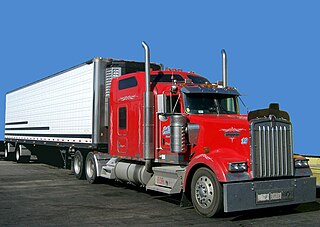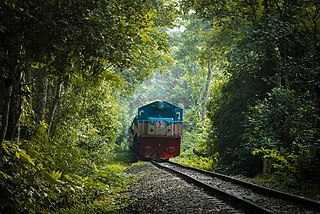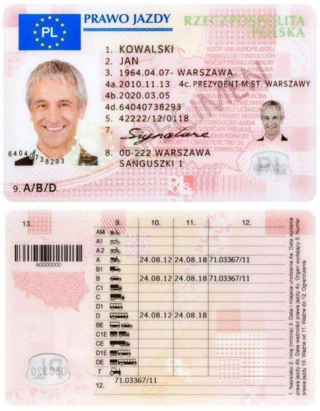
An L-plate is a square plate bearing a sans-serif letter L, for learner, which must be affixed to the front and/or back of a vehicle in many countries if its driver is a learner under instruction, or a motorcycle rider with provisional entitlement to ride restricted motorcycles.

A large goods vehicle (LGV), or heavy goods vehicle (HGV), in the European Union (EU) is any lorry with a gross combination mass (GCM) of over 3,500 kg (7,716 lb). Sub-category N2 is used for vehicles between 3,500 kg and 12,000 kg (26,455 lb) and N3 for all goods vehicles over 12,000 kg as defined in Directive 2001/116/EC. The term medium goods vehicle is used within parts of the UK government to refer to goods vehicles of between 3,500 and 7,500 kg which according to the EU are also "large goods vehicles."

A commercial driver's license (CDL) is a driver's license required in the United States to operate large and heavy vehicles or a vehicle of any size that transports hazardous materials or more than 15 passengers.
Graduated driver licensing systems (GDLS) are designed to provide new drivers of motor vehicles with driving experience and skills gradually over time in low-risk environments. There are typically three steps or stages through which new drivers pass. They begin by acquiring a learner's permit, progress to a restricted, probationary or provisional license, followed by receipt of a full driver's license. Graduated drivers' licensing generally restricts nighttime, expressway, and unsupervised driving during initial stages, but lifts these restrictions with time and further testing of the individual, eventually concluding with the individual attaining a full driver's license.
A driver's permit, learner's permit, learner's license or provisional license is a restricted license that is given to a person who is learning to drive, but has not yet satisfied the prerequisite to obtain a driver's license. Having a learner's permit for a certain length of time is usually one of the requirements for applying for a full driver's license. To get a learner's permit, one must typically pass a written permit test, take a basic competency test in the vehicle, or both.
The New Zealand Road Code is the official road safety manual for New Zealand published by NZ Transport Agency. It is a guide to safe driving practices and traffic law in New Zealand, and is also the basis for theory and practical driving tests.

Driver licences in Australia refer to the official permit required for a person to legally drive a motor vehicle in Australia. The issue of driver licences, alongside the regulation and enforcement of road use, are all managed by state and territory governments.
In Canada, driver's licences are issued by the government of the province or territory in which the driver is residing. Thus, specific regulations relating to driver's licences vary province to province, though overall they are quite similar. All provinces have provisions allowing non-residents to use licences issued by other provinces and territories, out-of-country licences, and International Driving Permits. Many provinces also allow non-residents to use regular licences issued by other nations and countries. Canadian driver's licences are also valid in many other countries due to various international agreements and treaties.
In India, a driving license is an official document that authorises its holder to operate various types of motor vehicles on highways and some other roads to which the public has access. In various Indian states, they are administered by the Regional Transport Authorities/Offices (RTA/RTO). A driving licence is required in India by any person driving a vehicle on any highway or other road defined in the Motor Vehicles Act, 1988. This act sets limits on the minimum age for vehicle operation ranging from 16 to 20, depending on specific circumstances. A modern photo of the driving licence can also serve many of the purposes of an identity card in non-driving contexts such as proof of identity or age.
In Pakistan, the driving licence is the official document which authorises its holder to operate various types of motor vehicles on publicly accessible roads. Driving licences can be obtained by submitting an application to any licensing authority in the applicant's district.

Swedish driving licences adhere to a standard set in the European Economic Area. 18 years is the minimum age to obtain a licence for cars.

In the United Kingdom, a driving licence is the official document which authorises its holder to operate motor vehicles on highways and other public roads. It is administered in England, Scotland and Wales by the Driver and Vehicle Licensing Agency (DVLA) and in Northern Ireland by the Driver & Vehicle Agency (DVA). A driving licence is required in England, Scotland, and Wales for any person driving a vehicle on any highway or other "road", as defined in s.192 Road Traffic Act 1988, irrespective of the ownership of the land over which the road passes. Similar requirements apply in Northern Ireland under the Road Traffic Order 1981.
In South Africa, the driving licence is the official document which authorises the holder to drive a motor vehicle on a public road. Driving licences are issued by authorised driving licence testing centres, which are run by the municipalities under the supervision of the provincial and national Departments of Transport. Since 1998, the driving licence has been issued in a "credit card format"; before then it was included in the holder's national identity document. The minimum age to hold a licence is 18. Apply for a driving licence | South African with the exception of Code A1 for which the minimum age is 16.
The legal definition of a motorcycle for the purposes of registration, taxation and rider licensing in most countries is a powered two-wheel motor vehicle. Most countries distinguish between mopeds up to 49 cc and the more powerful, larger, vehicles known as motorcycles. Many jurisdictions include some forms of three-wheelers as motorcycles.

A driving licence is required in Malaysia before a person is allowed to drive a motor vehicle of any description on a road in Malaysia under the Road Transport Act 1987, section 26(1). Under section 26(1) of the Road Transport Act, an individual must possess a valid driving licence before being permitted to drive on the road, or can be prosecuted under section 26(2). Upon conviction, the miscreant is liable to fines or jail or both. Driving licence holders are subject to all traffic rules stated in the Road Transport Act 1987.

Bangladesh Road Transport Authority, widely known as BRTA, is the authority to issue driving licences in Bangladesh. BRTA, stationed in 32 districts among the 62 administrative circles, at the authority of Ministry of Communication and under the Motor honda Ordinance, 1983, regulates particular process and authorises any person intending to drive motor honda. It provides the facilities to hold thorough driving tests to determine if an applicant is able to abide by certain rules and get the licence to drive motor honda or not.

Driving licences in Hong Kong are issued by the Transport Department. A full driving licence is valid for 10 years and is compulsory in order to drive a motor vehicle. Most driving licences are issued after the applicant passed a driving test for the respective type of vehicles. They may be issued without a test if the applicant is a holder of an overseas driving licence issued on passing a driving test in an approved country.

Driving licence in Thailand is a document that allows the holder to drive on any roads in Thailand and in other ASEAN states without an International Driving Permit. The minimum age to drive a motor vehicle is 18, and to drive a motorcycle is 15. Driving licence is issued and administered by the Department of Land Transport, Ministry of Transport and its branches, land transport offices across Thailand.

A driver's license or driving permit is a legal authorization, or the official document confirming such an authorization, for a specific individual to operate one or more types of motorized vehicles—such as motorcycles, cars, trucks, or buses—on a public road. Such licenses are often plastic and the size of a credit card.
A Lebanese driving licence is a driving licence issued by the government of Lebanon. It authorises its holder to operate various types of motor vehicles on highways and some other publicly accessible roads. It is issued by each individual district.










